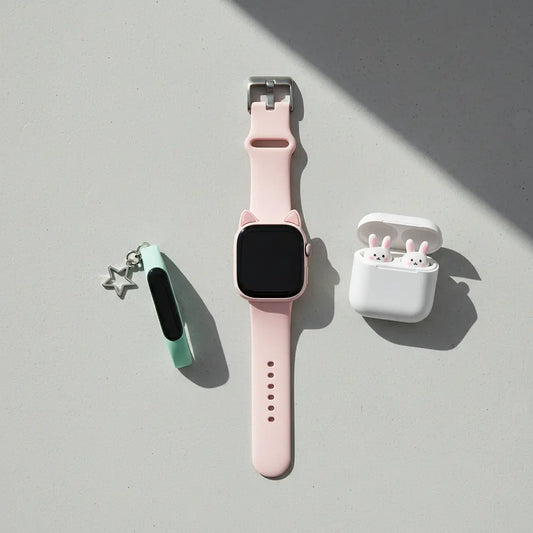
Best Cosplay Ear Attachment Methods Compared
You’ve perfected your elf makeup and styled your wig with precision. But halfway through the competition, you feel that dreaded slide—your cosplay ears are slipping. You try to subtly push them back into place, but the damage is done. Your focus is broken, and your character's illusion is shattered. Sound familiar?
For any serious cosplayer, an accessory failure is more than a minor annoyance. It's a breach in the world you’ve worked so hard to build. This guide is your definitive resource for solving that problem. We will benchmark the major ear attachment methods—magnets, clips, and adhesives—across durability, comfort, and invisibility.
This isn't about guesswork. It's about giving you the data to choose the best cosplay ears attachment method for your specific needs, whether you're on stage or on the convention floor. We will cover everything from high-performance magnet systems to hidden DIY hacks. The technology behind cosplay accessories is evolving rapidly, moving beyond simple attachments to complex, interactive elements. Understanding these mechanics is key to elevating your craft.
Explore the Tech Behind the Magic
Before we dive into attachment methods, have you ever wondered how some cosplay ears can twitch and react on their own? This technology is transforming what's possible in character expression. Explore the fascinating world of animatronics and see what the future of cosplay holds.
Discover How Moving Ears WorkLet’s break down the core methods and see how they perform under pressure.
Why Ear Attachment Matters in Competitive Cosplay
A secure set of cosplay ears is the difference between embodying a character and just wearing a costume. When your accessories are stable, you can perform with confidence, knowing every part of your look will hold up under stage lights and the rigors of a long convention day. The immersion remains intact for both you and your audience.
The most common frustrations stem from unreliable attachments. Ears can fall off during a dynamic pose for a photographer or, even worse, during a choreographed skit. Discomfort from poorly placed clips can become a distracting pain after a few hours. A visible or unnatural attachment point can also pull focus from your overall presentation, cheapening an otherwise flawless costume.
"Think about a 10-hour day at a major convention or a high-stakes stage performance. You need a solution that is not only secure but also comfortable and invisible. For a competitive cosplayer, a failing ear can be as detrimental as a split seam. It undermines the credibility you've worked months to build."
Attachment Method #1: Magnetic Cosplay Ears
Magnetic systems are a game-changer for performers who need reliability. The setup involves a strong magnet inside the base of the ear and a corresponding magnet placed underneath your wig or wig cap. When brought together, they create a powerful and secure hold that is completely hidden from view.
The strength of this method is its biggest asset. Using high-grade neodymium magnets (like N52 strength) ensures your ears can withstand sharp head turns, jumps, and even windy outdoor photoshoots. Unlike clips that can slide on smooth wig fibers, magnets anchor directly to the base, offering superior stability for secure cosplay ears.
Myth vs. Reality: Wig Damage
There is a common misconception that magnets will damage a delicate wig. When placed properly under the wefts or inside a sewn pouch in the wig cap, they distribute pressure evenly without harming the fibers. This makes the magnetic cosplay ears vs clip on debate a clear win for magnets in terms of performance and aesthetics.
A cosplayer wearing heavy, resin-cast elf ears for a full day at a convention reported no slippage. By sewing small felt pouches for the magnets inside her wig cap, she created a stable anchor that lasted from the opening ceremony to the final after-party, solving the problem of long-wear stability.
Attachment Method #2: Clip-On Cosplay Ears
Clip-on ears are the most accessible and widely available option, making them a popular choice for beginners or for casual cosplay. Typically attached with toupee clips or alligator clips, they can be positioned and adjusted in seconds without any complex setup. Their ease of use is their primary advantage.
However, their durability under movement is a significant concern for performers. The clips rely on gripping wig hair, which can be slippery. This often leads to the dreaded "ear slide," especially with heavier ears or during active use. They are best suited for static poses or short-term wear rather than a full day of walking or a dance routine.
Over a long convention day, the pressure points from the clips can also become uncomfortable or even cause headaches. The clips themselves can be difficult to hide completely, particularly on thinner wigs or with lighter hair colors. This can disrupt the natural silhouette you're aiming for with your character.
Think of clips as a convenient starting point. For a quick photoshoot or a character who doesn't require much movement, they work well. But for anyone asking how to attach elf ears to wig securely for a competition, clips often fall short of the reliability needed for a flawless performance.
Attachment Method #3: Adhesive & Glue Solutions
For the ultimate in realism, especially with latex cosplay ears or skin-like silicone cosplay ears, nothing beats a direct skin application with adhesives. This method involves using cosmetic-grade or medical-grade glues like Spirit Gum or Pros-Aide to bond the prosthetic directly to your skin, creating a seamless, invisible edge.
The strength of professional adhesives is unmatched, especially against sweat and heat. Stage performers and SFX artists rely on products like Pros-Aide to keep prosthetics secure for over 12 hours of rigorous activity. This makes it the best glue for attaching cosplay ears to wigs or skin when you absolutely cannot afford any movement.
Safety First: Patch Testing is Crucial
Safety is paramount when using these products. Always perform a patch test on your skin 24 hours before application to check for any allergic reaction. Removal requires a specific solvent matched to the adhesive to avoid damaging your skin. This method demands more prep and cleanup time than clips or magnets.
Imagine a dancer performing an intense routine on stage as a fantasy creature. With ears attached using a medical-grade adhesive, they blend perfectly with the skin and remain completely secure through every leap and spin. The adhesive provides a level of integration that other methods simply cannot replicate.
Hidden Hacks and DIY Secure Methods
The most innovative solutions often come from the cosplay community itself. When standard methods don't quite work, advanced cosplayers develop their own techniques for a flawless and secure cosplay ears setup. These hacks are particularly useful for complex situations like lace front wigs or uniquely shaped ears.
Attaching to Lace Front Wigs
Attaching cosplay ears to lace front wigs presents a unique challenge, as you want to avoid damaging the delicate lace. A popular solution is to sew a small, thin fabric pouch onto the sturdy wig cap *behind* the lace front. You can then slip a strong magnet into this pouch, allowing the ear to attach without putting any stress on the lace itself.
Hiding Attachments with Wig Styling
A simple but effective technique is to use the wig's own styling to conceal the attachment point. For cat ears wig attachment, you can tease the hair around the clip or magnet base to create volume that hides the mechanism. For an elf ears cosplay wig, let a few strands of hair fall naturally over the seam where the ear meets your head.
The DIY Magnetic Conversion
Don't have magnetic ears? You can create your own. Many cosplayers buy their favorite clip-on ears, carefully remove the clips, and use a strong epoxy glue (like E6000) to attach a neodymium magnet to the base. This DIY magnetic cosplay ears step by step process allows you to convert any pair of ears into a high-performance magnetic set.
For those interested in taking their DIY skills to the next level, understanding the mechanics behind these accessories is key. Building your own moving parts requires a solid grasp of electronics and construction. For a comprehensive guide on building animatronics from scratch, the go-to resource is our article, DIY Moving Cat Ears Tutorial for Cosplay. It provides the foundational knowledge you need for more advanced projects.
Access the Full DIY Tutorial HereComparison Table: Magnetic vs. Clip-On vs. Glue
Choosing the best cosplay ears attachment method depends on your specific needs for a costume. This table breaks down the key performance factors to help you decide. Is your priority all-day comfort, or do you need bomb-proof security for a stage competition? Use this as your guide.
| Feature | Magnetic System | Clip-On System | Adhesive/Glue |
|---|---|---|---|
| Durability Rating | ★★★★★ (Excellent) | ★★☆☆☆ (Fair) | ★★★★★ (Excellent) |
| Why? | Strong magnetic force creates a powerful lock that withstands intense movement, making it ideal for performers. | Relies on friction, which can fail on slippery wig fibers or with heavier ears. Prone to sliding. | Medical-grade adhesives form a chemical bond that is resistant to sweat, heat, and movement. |
| Comfort Rating | ★★★★☆ (Very Good) | ★★★☆☆ (Good) | ★★★☆☆ (Good) |
| Why? | Distributes pressure evenly under the wig. Can be worn for 10+ hours with minimal discomfort if placed correctly. | Pressure is concentrated on small points, which can cause soreness or headaches after a few hours of wear. | The adhesive itself is comfortable, but skin can become irritated during long wear or improper removal. |
| Visibility Rating | ★★★★★ (Excellent) | ★★☆☆☆ (Fair) | ★★★★★ (Excellent) |
| Why? | Completely hidden under the wig. No visible clips or bands, creating a perfectly seamless look. | Clips can be bulky and are often visible, especially on thin wigs or with certain hairstyles. | Blends directly into the skin, offering the most realistic and professional finish possible. |
| Best For | Competitions, long conventions, active performances, and cosplayers seeking a secure, invisible look. | Casual cosplay, short photoshoots, beginners, or trying out a new character look without commitment. | SFX-heavy looks, skin-adhered prosthetics (latex cosplay ears), and stage performances requiring total realism. |
This comparison shows a clear winner for serious cosplayers. When you compare magnetic cosplay ears vs clip on, the magnetic option consistently provides better security and a cleaner look. Adhesives offer peak realism but require more skill and preparation.
Expert Tips for Beginner and Advanced Cosplayers
Avoiding a cosplay ears falling off fix mid-convention starts with proper preparation. Whether you're a beginner or a seasoned competitor, these pro-tips will help you achieve a secure and natural-looking attachment that lasts all day.
For All Cosplayers: The Foundation is Key
- Prep Your Wig: Before attaching clips, lightly spray the wig hair with hairspray where the clip will sit. This creates texture and gives the clip something to grip, reducing slippage.
- Anchor Your Wig Securely: Your ears are only as secure as the wig they're attached to. Use a high-quality wig grip band and bobby pins to ensure your wig itself won’t shift during the day.
- Perform a Stress Test: Before leaving for your event, put on your full costume and move around. Do some head turns, jumps, and bends. It’s better to find a weakness at home than on the convention floor.
For Advanced Cosplayers: Performance-Proofing
- Double Up on Magnets: For very heavy or large ears (like furry cosplay ears), consider using two smaller magnet pairs per ear instead of one large one. This distributes the weight and creates a more stable anchor.
- Blend the Seams: For skin-applied elf ears cosplay wig styles, use a bit of liquid latex or stippled makeup around the edge to blur the line between the prosthetic and your skin. This small detail elevates the entire look.
- Carry a Mini Repair Kit: Pack a small kit with extra magnets, a travel-size adhesive, or a few toupee clips. Being prepared for a quick fix provides peace of mind.
If you ever run into issues with more complex animatronic ears, troubleshooting can be a challenge. Finding the source of a wiring fault or mechanical failure requires a systematic approach. For a complete breakdown of common problems and solutions, we recommend our guide, Fixing Cosplay Ears: 2025 Troubleshooting & Alternatives.
Get the Ultimate Troubleshooting GuideFinal Recommendation: Choosing the Best Method for You
The best cosplay ears attachment method is not one-size-fits-all. It depends entirely on your character, your performance environment, and your personal priorities. Let’s break it down with a few common scenarios to help you make the perfect choice.
Scenario 1: The Competitive Stage Performer
Your Need: You're in a dance competition or a theatrical skit with dynamic movements. Your ears absolutely cannot move or fall off. Realism is a bonus, but security is non-negotiable.
Your Best Method: Adhesives or a strong magnetic system. Pros-Aide glue offers the ultimate bond for skin-applied prosthetics. For wig-mounted ears, a well-placed N52 neodymium magnet system is your most reliable choice.
Scenario 2: The 12-Hour Convention Veteran
Your Need: You'll be wearing your cosplay from morning until night, walking the floor, posing for photos, and interacting with crowds. You need a balance of security, comfort, and invisibility.
Your Best Method: A magnetic system. Magnets provide all-day security without the pressure points of clips. They remain hidden for flawless photos from any angle and are comfortable enough for extended wear, making them a top choice for `secure cosplay ears`.
Scenario 3: The Casual Cosplayer and Photoshoot Enthusiast
Your Need: You're doing a planned outdoor photoshoot or wearing a costume for a few hours at a local meetup. Ease of use and quick setup are your main priorities.
Your Best Method: Clip-on ears. For short-term wear and static posing, clips are perfectly adequate and incredibly convenient. They offer a great cosplay ears without headband tutorial-free experience, allowing you to get into character quickly.
Ultimately, your choice is a strategic one. Analyze the demands of your next event and select the method that empowers you to perform with total confidence.
Your cosplay ears are a critical part of your character's silhouette and story. Choosing the right attachment method is a foundational step in bringing that character to life with confidence and credibility. An unstable accessory can break your focus and your performance, while a secure one lets you fully inhabit your role.
We've seen that while clips offer convenience for casual use, magnetic systems provide a superior blend of security, comfort, and invisibility for serious convention-goers. For performers demanding absolute realism and a bond that defies sweat and movement, professional adhesives are the gold standard.
Empower your cosplay by making an informed choice. Invest in the method that matches your performance needs, and you'll never have to worry about a slipping ear again. This level of craftsmanship extends beyond just ears. The rise of expressive accessories like animatronic tails shows a growing trend where technology and artistry merge to create truly immersive characters.
Join the Next Wave of Cosplay
The trend of expressive cosplay accessories is growing beyond the convention floor. See how items like fox tails are becoming a part of everyday alternative fashion and why this movement is capturing the imagination of a new generation.
Explore the Fox Tail TrendFrequently Asked Questions
1. How do I securely attach elf ears to a wig without a headband?
The most secure method is using magnets. Place one magnet inside the base of the elf ear and the other under your wig, secured to the wig cap. This creates a strong, invisible hold. For an even more permanent solution, you can sew the base of the ear directly onto the wig wefts near the hairline.
2. What is the best glue for attaching latex or silicone ears directly to my skin?
For professional-grade results, Pros-Aide is the industry standard. It's a medical-grade, water-based adhesive that is strong, flexible, and sweat-resistant. Spirit Gum is another popular option for lighter prosthetics, but it is less durable than Pros-Aide. Always use the appropriate remover for your chosen adhesive.
3. Can magnetic cosplay ears fall off easily during a performance?
If you use high-quality neodymium magnets (N52 strength is recommended) and have them positioned correctly, it is extremely unlikely they will fall off during a performance. The magnetic force is very strong and designed to withstand sharp movements, making them a reliable choice for dancers and stage actors.
4. How can I hide the clips on my cosplay ears better?
To hide clips, position them deep under a thick weft of wig hair. You can also "tease" or backcomb the hair around the clip's base to create volume that covers it. Another trick is to choose clips that match the color of your wig's roots to help them blend in more effectively.




